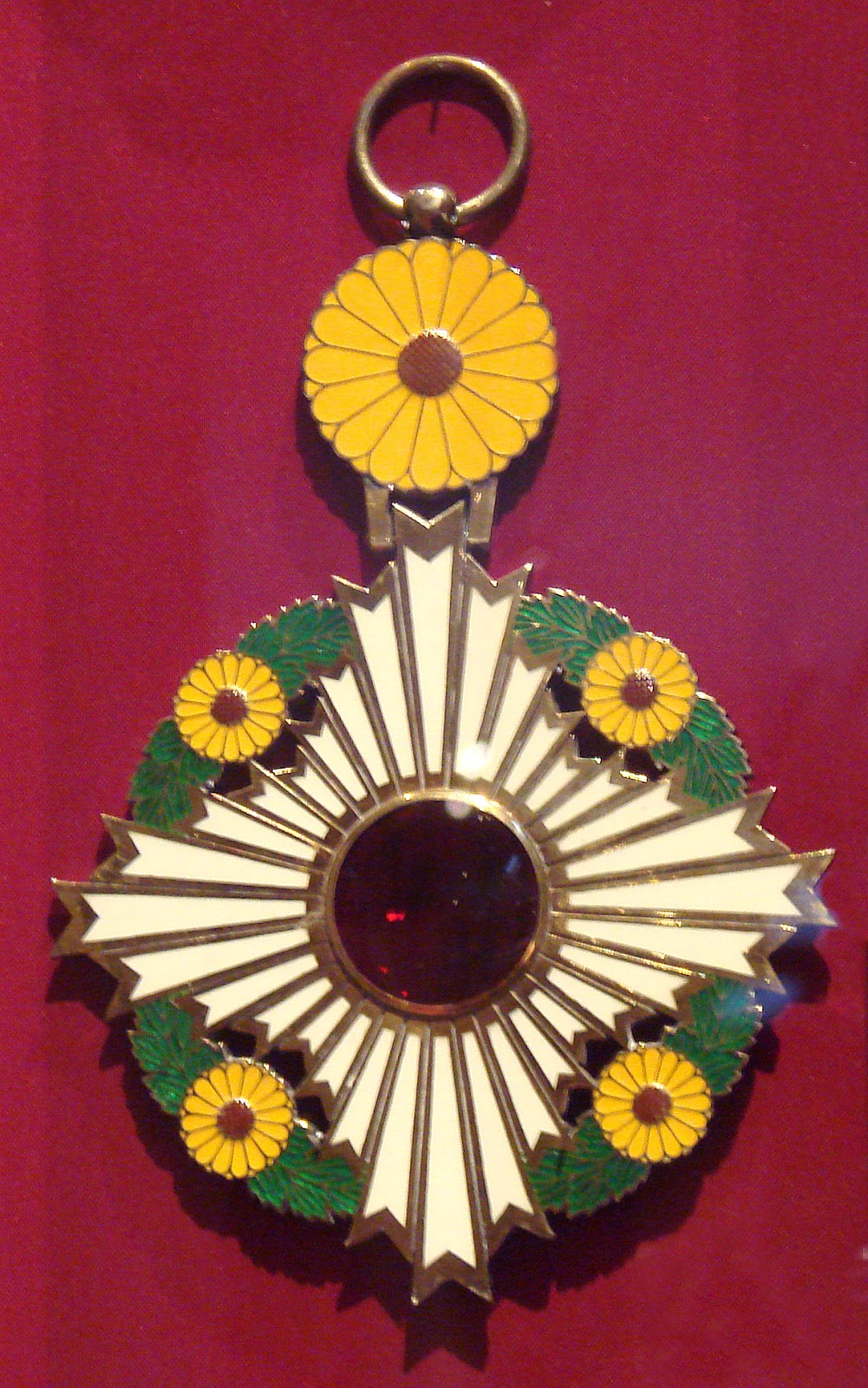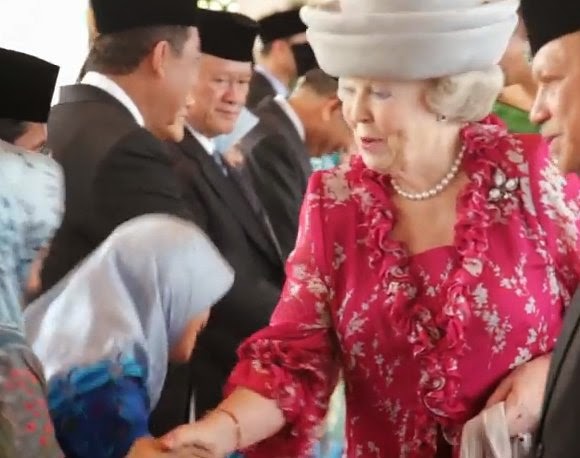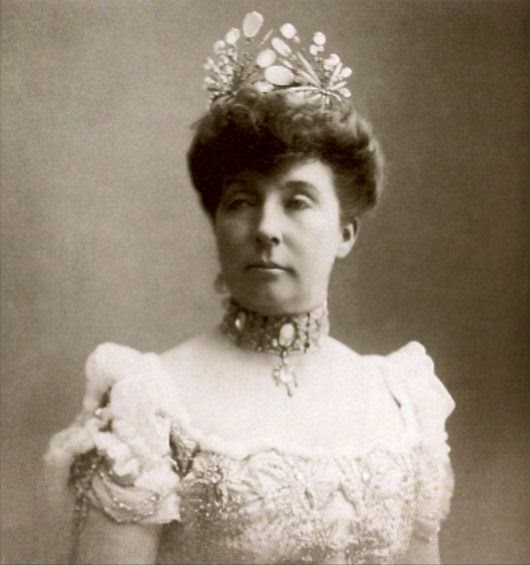Still having trouble deciding what to wear for Halloween this weekend, dear readers? Well, you’re in luck: I’ve brought along some inspiration today just for you! During World War II, Princesses Elizabeth and Margaret were tucked away at Windsor Castle for safekeeping. Every year, they put on pantomimes with elaborate costumes to entertain themselves and the rest of the castle’s residents. Just check out some of these outfits!
The Order of the Chrysanthemum
Margrethe II of Denmark wears the order, 2004
King Willem-Alexander and Queen Maxima of the Netherlands are in Japan this week, dropping in on their imperial counterparts, Emperor Akihito and Empress Michiko. A glittering state banquet is planned, and when the Dutch king steps into the ballroom, he’ll be wearing the red and blue sash of Japan’s highest chivalric order: the Order of the Chrysanthemum.
Queen Elizabeth II wears the order, 1975
The Order of the Chrysanthemum is the highest order of chivalry in Japan. As far as chivalric orders go, this one’s pretty new: it was developed by Emperor Meiji over ten years in the 1870s and 1880s. The emperor is the order’s sovereign, and it is awarded “at his pleasure.” If you’re a Japanese citizen, this is the highest national order you can get, and it is very rarely awarded. And, in an interesting quirk, you can get it even if you’ve already died — appropriate for a culture that honors the spirits of its ancestors, the order can be awarded posthumously. The order only has one class, but sometimes recipients are given the collar of the order (the highest “rank”) while others are given the grand cordon.

The chrysanthemum flower is an important symbol of Japan’s monarchy. The phrase “Chrysanthemum Throne” is used to refer to Japan’s emperor and imperial family. The flower is on the imperial seal; the empress wears a diamond tiara with chrysanthemum motifs; and the nation’s highest order of chivalry also features the flower prominently in its insignia. The order’s badge and star feature a four-pointed white enamel star with a cabochon garnet set in its center, surrounded by yellow chrysanthemum blossoms and green chrysanthemum leaves. The order’s sash is red with blue stripes at each border.
Mohammed VI of Morocco wears the order, 2005
Ordinarily, the order is only awarded to men. But when foreign royals — specifically sovereigns and heirs to the throne — are considered, the order is also given to women. Queen Elizabeth II has the order; so does Queen Margrethe II of Denmark. Other living monarchs to have the highest “rank” of the order (the collar) include Harald V of Norway, Carl XVI Gustaf of Sweden, Abdullah II of Jordan, and Mohammed VI of Morocco.
Albert II and Philippe of Belgium wear the order, 1996
The lower “rank” of the Chrysanthemum, the grand cordon, is often given to monarchs’ heirs. Crown Princess Victoria of Sweden has the grand cordon, and so do the Prince of Wales and Crown Prince Frederik of Denmark. But you don’t have to be the heir to get the grand cordon — the Duke of Edinburgh has it, and so does Prince Joachim, the second son of the Danish queen. King Philippe of Belgium also has the grand cordon, though I’d expect we can see him “upgraded” the next time the two nations meet for a state visit.
King Willem-Alexander just received one of those “upgrades.” He already had the grand cordon of the Chrysanthemum, but on Friday, the Japanese Ministry of Foreign Affairs announced that he had been given the collar of the order. The Japanese also recognized his wife, awarding Queen Maxima the grand cordon of the Order of the Precious Crown, the Japanese chivalric order that is reserved for women. (And get excited: word on the street is that Crown Princess Masako is expected to attend this particular state banquet!)
The Top Ten: Royal Opals
October babies, let’s face it: you’ve got a pretty cool birthstone. Opals come in a variety of colors, and often they look like they’re literally glowing from within. Most of the world’s opals are mined in Australia, so it’s no surprise that it’s also the country’s national gemstone. Royals have been attracted to opals for centuries, from the “Burning of Troy” opal given by Napoleon to Josephine all the way to the present day, though many royal collections lack major opal pieces. Today, we’re running down ten of the most intriguing opals in royal collections past and present.
10. Queen Letizia’s Pink Opal Earrings: Letizia’s jewelry collection includes the “Dinah” pink opal earrings from Tous, a Barcelona-based jewelry company. (See a closer image of the earrings here.) The new Spanish queen prefers extremely delicate, minimalist jewelry, so these drop earrings are actually some of the more substantial in her jewelry box. The earrings retail for $540 and can be purchased here.
 |
| (source) |
9. The Dutch Opal Flower Brooch: The Dutch royal family’s jewel foundation includes a 19th-century flower brooch set with milky opals and a single ruby. Queen Juliana wore the piece during the 1970s, and Princess Beatrix brought it out of the vaults during the final months of her reign for a state visit to Brunei. (Read more at John’s website.)
8. The Australian Opal Spray Brooch: Since opals are Australia’s national gemstone, and Elizabeth II is the Queen of Australia, you’d be correct in assuming that her jewelry box included several opals. This one was one of her wedding gifts in 1947, from the Returned Sailors, Soldiers and Airmen Imperial League of Australia. It features black opals set in gold.
7. Crown Princess Mary’s Opal Pendant: To mark the first birthday of Prince Christian of Denmark (an October baby!), a Sydney-based jeweler reportedly presented the Australian-born Crown Princess Mary with an opal pendant necklace. (The gift apparently came with jewelry for Crown Prince Frederik as well: a set of opal cuff links.) I don’t think Mary has ever worn this necklace in public; if she has, please point me toward pictures!

6. Princess Marie’s Opal Parure: In the late nineteenth century, Princess Marie d’Orléans, the wife of Prince Valdemar of Denmark, owned a striking parure of jewels set with opals and moonstones. The opal tiara ended up with her son, Prince Viggo; it was substantially remade to look like a more traditional tiara and worn by his wife, Eleanor. More recently, it was worn by Viggo’s daughter-in-law, the late Countess Ruth of Rosenborg. The choker that Marie wears in the portrait above is owned today by Chantal d’Orléans.
5. The Dutch Fire Opal Brooch: Princess Beatrix of the Netherlands has a collection of private jewelry separate from the family’s jewel foundation. It includes a set of fire opal and diamond jewels: a bracelet, a brooch, a ring, and a pair of earrings. Fire opals are an especially appropriate stone for the Dutch royals, as they’re often found in shades of yellow-orange. Beatrix sometimes loans the set to Queen Maxima, who wore them to an awards ceremony last year. (As always, more at John’s website.)
4. Queen Mercedes’s Opal Ring: Just in time for Halloween, it’s a cursed opal! For their wedding in 1878, King Alfonso XII and Queen Mercedes of Spain (pictured above) were given an opal ring by one of his former mistresses. The story goes that Mercedes (probably not having been clued in about the giver’s former relationship with her husband) wore the ring — and then she died. Alfonso passed along the ring to his grandmother, Queen Maria Cristina — and then she died. Next, he gave the ring to his sister, Infanta Maria del Pilar — and then she died. Eventually Alfonso puts the ring on himself, and you guessed it — he died. Of course, Mercedes had typhoid fever even before her marriage, Maria Cristina was 72, and Alfonso had tuberculosis and dysentery. But maybe it’s for the best that the family reportedly gave the ring to Madrid’s cathedral — you know, just in case.
3. Queen Alexandra’s Opal Parure: When Princess Alexandra of Denmark married the Prince of Wales in 1863, her new mother-in-law, Queen Victoria, gave her a suite of opal and diamond jewels. The set included a cross pendant, a set of three brooches, a pair of earrings, and a bracelet (which Alexandra wore on her wedding day). The late Prince Albert had apparently drawn the designs for the set, which was made by Garrard. But Alexandra was not a fan of opals — a novel by Sir Walter Scott had popularly depicted them as a symbol of bad luck — and some have suggested that she had these pieces reset after Victoria’s death. I’m not sure that’s the case — the sources I have aren’t clear on the pieces’ fates — but either way, Alexandra’s opals don’t seem to be hanging about in royal hands these days.
2. The Oriental Circlet: Alexandra didn’t stop her opal makeover with her own jewels — she also had other opal pieces in the royal collection reset with Burmese rubies. Among these were Queen Victoria’s Oriental Circlet, designed by Prince Albert and set with opals, one of his favorite gemstones, as well as a necklace and a pair of pendant earrings. All of these formerly-opal jewels remain with the royal family today.
1. The Andamooka Opals: During her tour of Australia in 1954 (pictured above), Queen Elizabeth II was presented with an astonishing set of opal jewels. The necklace and earrings were set with opals that had been discovered in the Andamooka opal fields; the enormous opal in the necklace weighs more than 200 carats. Elizabeth wore the set once during the tour, pairing it with Queen Mary’s lover’s knot tiara — and then put it in the royal vaults. I can see that it’s perhaps not to the Queen’s taste — the necklace especially is an unusual modern piece — but surely there’s someone in the family (*cough* Kate? *cough*) who could take this set out for a spin.